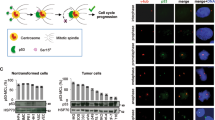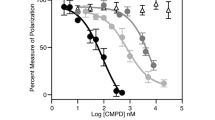Abstract
Centrosome duplication is a carefully controlled process in the cell cycle. Previous studies indicate that the tumor suppressor, p53, regulates centrosome duplication. Here, we present evidence for the involvement of the mammalian Krüppel-like transcription factor, KLF4, in preventing centrosome amplification following DNA damage caused by γ-irradiation. The colon cancer cell line HCT116, which contains wild-type p53 alleles (HCT116 p53+/+), displayed stable centrosome numbers following γ-irradiation. In contrast, HCT116 cells null for the p53 alleles (HCT116 p53−/−) exhibited centrosome amplification after irradiation. In the latter cell line, KLF4 was not activated following γ-irradiation due to the absence of p53. However, centrosome amplification could be suppressed in irradiated HCT116 p53−/− cells by conditional induction of exogenous KLF4. Conversely, in a HCT116 p53+/+ cell line stably transfected with small hairpin RNA (shRNA) designed to specifically inhibit KLF4, γ-irradiation induced centrosome amplification. In these cells, the inability of KLF4 to become activated in response to DNA damage was directly associated with an increase in cyclin E level and Cdk2 activity, both essential for regulating centrosome duplication. Cotransfection experiments showed that KLF4 overexpression suppressed the promoter activity of the cyclin E gene. The results of this study demonstrated that KLF4 is both necessary and sufficient in preventing centrosome amplification following γ-radiation-induced DNA damage and does so by transcriptionally suppressing cyclin E expression.
This is a preview of subscription content, access via your institution
Access options
Subscribe to this journal
Receive 50 print issues and online access
$259.00 per year
only $5.18 per issue
Buy this article
- Purchase on Springer Link
- Instant access to full article PDF
Prices may be subject to local taxes which are calculated during checkout






Similar content being viewed by others
Abbreviations
- BSA:
-
bovine serum albumin
- Cdk2:
-
cyclin-dependent kinase 2
- DPBS:
-
Dulbecco's phosphate-buffered saline
- FBS:
-
fetal bovine serum
- GKLF:
-
gut-enriched Krüppel-like factor
- KLF4:
-
Krüppel-like factor 4
- MEFs:
-
mouse embryonic fibroblasts
- PBS:
-
phosphate-buffered saline
- shRNA:
-
small hairpin RNA
References
Al-Romaih K, Bayani J, Vorobyova J, Karaskova J, Park PC, Zielenska M and Squire JA . (2003). Cancer Genet. Cytogenet., 144, 91–99.
Bennett RA, Izumi H and Fukasawa K . (2004). Oncogene, 23, 6823–6829.
Botz J, Zerfass-Thome K, Spitkovsky D, Delius H, Vogt B, Eilers M, Hatzigeorgiou A and Jansen-Durr P . (1996). Mol. Cell. Biol., 16, 3401–3409.
Bunz F, Dutriaux A, Lengauer C, Waldman T, Zhou S, Brown JP, Sedivy JM, Kinzler KW and Vogelstein B . (1998). Science, 282, 1497–1501.
Bunz F, Fauth C, Speicher MR, Dutriaux A, Sedivy JM, Kinzler KW, Vogelstein B and Lengauer C . (2002). Cancer Res., 62, 1129–1133.
Carder P, Wyllie AH, Purdie CA, Morris RG, White S, Piris J and Bird CC . (1993). Oncogene, 8, 1397–1401.
Carroll PE, Okuda M, Horn HF, Biddinger P, Stambrook PJ, Gleich LL, Li YQ, Tarapore P and Fukasawa K . (1999). Oncogene, 18, 1935–1944.
Chen X, Johns DC, Geiman DE, Marban E, Dang DT, Hamlin G, Sun R and Yang VW . (2001). J. Biol. Chem., 276, 30423–30428.
Dang DT, Mahatan CS, Dang LH, Agboola IA and Yang VW . (2001). Oncogene, 20, 4884–4890.
Donehower LA, Godley LA, Aldaz CM, Pyle R, Shi YP, Pinkel D, Gray J, Bradley A, Medina D and Varmus HE . (1996). Prog. Clin. Biol. Res., 395, 1–11.
Duensing S, Lee LY, Duensing A, Basile J, Piboonniyom S, Gonzalez S, Crum CP and Munger K . (2000). Proc. Natl. Acad. Sci. USA, 97, 10002–10007.
Ekholm SV, Zickert P, Reed SI and Zetterberg A . (2001). Mol. Cell. Biol., 21, 3256–3265.
el-Deiry WS, Tokino T, Velculescu VE, Levy DB, Parsons R, Trent JM, Lin D, Mercer WE, Kinzler KW and Vogelstein B . (1993). Cell, 75, 817–825.
Fukasawa K, Choi T, Kuriyama R, Rulong S and Vande Woude GF . (1996). Science, 271, 1744–1747.
Fukasawa K, Wiener F, Vande Woude GF and Mai S . (1997). Oncogene, 15, 1295–1302.
Garrett-Sinha LA, Eberspaecher H, Seldin MF and de Crombrugghe B . (1996). J. Biol. Chem., 271, 31384–31390.
Geng Y, Eaton EN, Picon M, Roberts JM, Lundberg AS, Gifford A, Sardet C and Weinberg RA . (1996). Oncogene, 12, 1173–1180.
Ghadimi BM, Sackett DL, Difilippantonio MJ, Schrock E, Neumann T, Jauho A, Auer G and Ried T . (2000). Genes Chromosomes Cancer, 27, 183–190.
Harvey M, Sands AT, Weiss RS, Hegi ME, Wiseman RW, Pantazis P, Giovanella BC, Tainsky MA, Bradley A and Donehower LA . (1993). Oncogene, 8, 2457–2467.
Hinchcliffe EH, Li C, Thompson EA, Maller JL and Sluder G . (1999). Science, 283, 851–854.
Hinchcliffe EH and Sluder G . (2001). Genes Dev., 15, 1167–1181.
Hinchcliffe EH and Sluder G . (2002). Oncogene, 21, 6154–6160.
Hollstein M, Sidransky D, Vogelstein B and Harris CC . (1991). Science, 253, 49–53.
Joshi HC, Palacios MJ, McNamara L and Cleveland DW . (1992). Nature, 356, 80–83.
Kawamura K, Izumi H, Ma Z, Ikeda R, Moriyama M, Tanaka T, Nojima T, Levin LS, Fujikawa-Yamamoto K, Suzuki K and Fukasawa K . (2004). Cancer Res., 64, 4800–4809.
Kellogg DR . (1989). Nature, 340, 99–100.
Kirschner MW and Mitchison T . (1986). Nature, 324, 621.
Kuo KK, Sato N, Mizumoto K, Maehara N, Yonemasu H, Ker CG, Sheen PC and Tanaka M . (2000). Hepatology, 31, 59–64.
Lee JM, Abrahamson JL, Kandel R, Donehower LA and Bernstein A . (1994). Oncogene, 9, 3731–3736.
Lingle WL, Barrett SL, Negron VC, D'Assoro AB, Boeneman K, Liu W, Whitehead CM, Reynolds C and Salisbury JL . (2002). Proc. Natl. Acad. Sci. USA, 99, 1978–1983.
Lingle WL, Lutz WH, Ingle JN, Maihle NJ and Salisbury JL . (1998). Proc. Natl. Acad. Sci. USA, 95, 2950–2955.
Lingle WL and Salisbury JL . (1999). Am. J. Pathol., 155, 1941–1951.
Mantel C, Braun SE, Reid S, Henegariu O, Liu L, Hangoc G and Broxmeyer HE . (1999). Blood, 93, 1390–1398.
Mayer F, Stoop H, Sen S, Bokemeyer C, Oosterhuis JW and Looijenga LH . (2003). Oncogene, 22, 3859–3866.
Mussman JG, Horn HF, Carroll PE, Okuda M, Tarapore P, Donehower LA and Fukasawa K . (2000). Oncogene, 19, 1635–1646.
Ohtani K, DeGregori J and Nevins JR . (1995). Proc. Natl. Acad. Sci. USA, 92, 12146–12150.
Ouyang X, Wang X, Xu K, Jin DY, Cheung AL, Tsao SW and Wong YC . (2001). Biochim. Biophys. Acta, 1541, 212–220.
Pihan GA, Purohit A, Wallace J, Knecht H, Woda B, Quesenberry P and Doxsey SJ . (1998). Cancer Res., 58, 3974–3985.
Pihan GA, Purohit A, Wallace J, Malhotra R, Liotta L and Doxsey SJ . (2001). Cancer Res., 61, 2212–2219.
Pihan GA, Wallace J, Zhou Y and Doxsey SJ . (2003). Cancer Res., 63, 1398–1404.
Sato N, Mizumoto K, Nakamura M, Maehara N, Minamishima YA, Nishio S, Nagai E and Tanaka M . (2001). Cancer Genet. Cytogenet., 126, 13–19.
Sato N, Mizumoto K, Nakamura M, Nakamura K, Kusumoto M, Niiyama H, Ogawa T and Tanaka M . (1999). Clin. Cancer Res., 5, 963–970.
Schatten H, Wiedemeier AM, Taylor M, Lubahn DB, Greenberg NM, Besch-Williford C, Rosenfeld CS, Day JK and Ripple M . (2000). Biol. Cell, 92, 331–340.
Shields JM, Christy RJ and Yang VW . (1996). J. Biol. Chem., 271, 20009–20017.
Shields JM and Yang VW . (1997). J. Biol. Chem., 272, 18504–18507.
Sluder G, Thompson EA, Miller FJ, Hayes J and Rieder CL . (1997). J. Cell Sci., 110 (Part 4), 421–429.
Tarapore P and Fukasawa K . (2002). Oncogene, 21, 6234–6240.
Tarapore P, Okuda M and Fukasawa K . (2002). Cell Cycle, 1, 75–81.
Tokuyama Y, Horn HF, Kawamura K, Tarapore P and Fukasawa K . (2001). J. Biol. Chem., 276, 21529–21537.
Vogelstein B, Lane D and Levine AJ . (2000). Nature, 408, 307–310.
Waldman T, Kinzler KW and Vogelstein B . (1995). Cancer Res., 55, 5187–5190.
Weaver Z, Montagna C, Xu X, Howard T, Gadina M, Brodie SG, Deng CX and Ried T . (2002). Oncogene, 21, 5097–5107.
Weber RG, Bridger JM, Benner A, Weisenberger D, Ehemann V, Reifenberger G and Lichter P . (1998). Cytogenet. Cell Genet., 83, 266–269.
Yoon HS, Chen X and Yang VW . (2003). J. Biol. Chem., 278, 2101–2105.
Yoon HS and Yang VW . (2004). J. Biol. Chem., 279, 5035–5041.
Zhang W, Geiman DE, Shields JM, Dang DT, Mahatan CS, Kaestner KH, Biggs JR, Kraft AS and Yang VW . (2000). J. Biol. Chem., 275, 18391–18398.
Zhang W, Shields JM, Sogawa K, Fujii-Kuriyama Y and Yang VW . (1998). J. Biol. Chem., 273, 17917–17925.
Zhao W, Hisamuddin IM, Nandan MO, Babbin BA, Lamb NE and Yang VW . (2004). Oncogene, 23, 395–402.
Acknowledgements
We thank Dr B Vogelstein for providing the HCT116 p53+/+ and HCT116 p53−/− cell line and Dr R Weinberg for providing the cyclin E luciferase reporter plasmid. This work was in part supported by grants from the National Institutes of Health (DK52230, DK64399, and CA84197). VWY is the recipient of a Georgia Cancer Coalition Distinguished Cancer Clinician Scientist award. WBD is a recipient of a Medical Scientist Training Program grant.
Author information
Authors and Affiliations
Corresponding author
Rights and permissions
About this article
Cite this article
Yoon, H., Ghaleb, A., Nandan, M. et al. Krüppel-like factor 4 prevents centrosome amplification following γ-irradiation-induced DNA damage. Oncogene 24, 4017–4025 (2005). https://doi.org/10.1038/sj.onc.1208576
Received:
Revised:
Accepted:
Published:
Issue Date:
DOI: https://doi.org/10.1038/sj.onc.1208576
Keywords
This article is cited by
-
Integrated whole transcriptome profiling revealed a convoluted circular RNA-based competing endogenous RNAs regulatory network in colorectal cancer
Scientific Reports (2024)
-
Centrosome amplification: a quantifiable cancer cell trait with prognostic value in solid malignancies
Cancer and Metastasis Reviews (2021)
-
Genome-wide association study identifies genetic susceptibility loci and pathways of radiation-induced acute oral mucositis
Journal of Translational Medicine (2020)
-
FBXO32 suppresses breast cancer tumorigenesis through targeting KLF4 to proteasomal degradation
Oncogene (2017)
-
Inactivation of KLF4 promotes T-cell acute lymphoblastic leukemia and activates the MAP2K7 pathway
Leukemia (2017)



